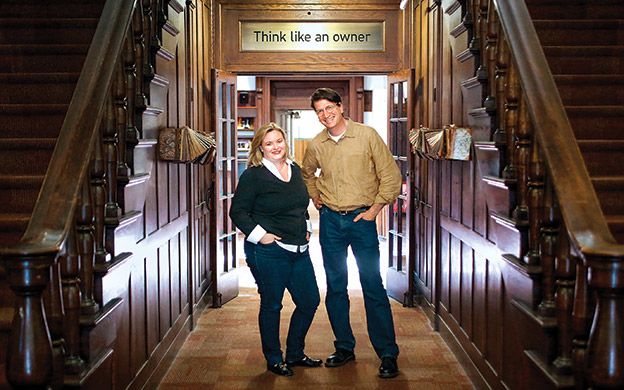The Via Agency joins Maine's growing ESOP roster
 Photo / Tim Greenway
The VIA Agency CEO Leeann Leahy and founder and Chairman John Coleman at the agency's offices in the Baxter Building, which dates to 1888 and was the original site of the Portland Public Library. The offices are just one aspect of VIA's recruiting strategy.
Photo / Tim Greenway
The VIA Agency CEO Leeann Leahy and founder and Chairman John Coleman at the agency's offices in the Baxter Building, which dates to 1888 and was the original site of the Portland Public Library. The offices are just one aspect of VIA's recruiting strategy.
Like a lot of small business owners, The VIA Agency founder and Chairman John Coleman didn't relish the prospect of a giant out-of-state operator swallowing advertising agency he spent 23 years building. An Employee Stock Ownership Plan (ESOP) offered a promising alternative.
But the ESOP also offered another important promise: it could help recruit and retain the kind of creative, motivated and independent thinkers Coleman needed on staff.
“The ESOP is a very powerful aspect to attracting the best talent,” says Coleman. “Over time, employees will have the freedom to be involved in the direction of the company, plus they'll have the economic upside in participating in the value that's created. For our associates, it's a wonderful compromise between going to work for a big agency and having your own shop.”
Portland-based VIA is Maine's largest ad agency, with $33 million in revenues. Clients include Perdue, People's United Bank, Klondike, Pacific Life, Facebook and Unilever. In 2011 Ad Age named VIA “best small agency.”
To Coleman, VIA's ability to maintain that momentum hinges on the agency's capacity to compete for top talent in major metro areas, including New York and Chicago, as well as technology companies like Google and Apple, which are now luring the best and the brightest from the ad world. More than half of VIA's staff is from out of state.
“Every pitch is extraordinarily competitive. The biggest point of differentiation is your talent,” says Coleman. “So how you take care of that talent determines how well they can perform in any given situation.” And how long they stay with the company. After all, clients value a staff with longevity. “Clients want stability, and people with institutional knowledge about their company,” he adds.
VIA joins the growing ranks of Maine businesses that have converted or are converting to an ESOP structure, including Landry/French Construction Co., Kennebec Technologies, GAC Chemical Corp. and Sargent Corp.
In Maine, many ESOP transactions have been facilitated by Susan Scherbel, a principal at Bellview Associates, which has offices in Chicago, New York City and Ellsworth. She says that there has been growing interest in ESOPs from business owners who want to ensure the continuity of their businesses, but don't want to sell to a competitor, private equity firm or an out-of-state operator. Firms like VIA are seeing ESOPs as a powerful retention tool.
“Increasingly, business owners are saying that if we don't do this, we can't be competitive because it's a very difficult environment to attract and retain good people,” she says.
A long-term plan
VIA's ESOP offers employees new opportunities for equity ownership in addition to participation in the profit-sharing bonus program that has been in place since the company began.
If the company meets yearly targets for profitability, growth and performance, Coleman and his wife Linda (a co-owner of the company) will issue up to 9% of the value of the company into a pool of options. Each of the company's 100 employees will receive a portion of this options pool, which gives them the right to purchase shares at a specific price in the future.
The number of options each employee gets is determined by his or her responsibility at the company as well a pro-rata portion of base salary. If the company is sold, each employee can convert their options to shares and sell them.
If an employee leaves after the options have been converted to shares, they can sell those shares back to the company. However, if the employee leaves while they still hold options, those options are forfeited.
Coleman says that a conventional qualified IRS ESOP model was too inflexible, costly and complex for what he hoped to accomplish. For example, he wanted to transfer equity against specific criteria while maintaining full control of the company.
“I wanted to have the ability to make decisions as the transition happened,” he says. “Before I started transferring control to employees, I wanted to design a program that I believe is going to be good for the associates, the shareholders and the future of the company.”
He also wanted to motivate employees to stay for the long term. After all, the longer they stay — and the better the company performs — the greater the potential financial upside.
“A longer-term transition plan will allow the associates to slowly learn how to run and govern the agency most effectively,” says Coleman. “I wanted to the ability to make decisions as the transition happened. Before I started transferring control to employees, I wanted to design a program that I believe is going to be good for the associates and the future of the company.”
Gary Bergeron, vice president and financial advisor with The Breakwater Group at Morgan Stanley, advised Coleman during the planning process. He says that while structuring the ESOP in this way may have involved some trade-offs in terms of tax benefits, “there is no single succession solution that works for all companies and cultures.”
“John has created what feels right for him, his family, and for the long-term viability of the firm as a whole,” says Bergeron.
Think like an owner
VIA CEO Leeann Leahy says that in the weeks that the ESOP was announced, the 'think like an owner' mentality has already taken hold among VIA staffers.
“As long as we all grow and succeed together, we have the opportunity to grow and create personal wealth,” she says.
With the ESOP conversion, more details about the company's financial performance are being shared company-wide more often, with the hope that increased transparency will help enhance a sense of shared responsibility among associates.
“There's a sense that we're a giant set of dominoes,” Leahy says. “Everyone is responsible to everyone else. And we're a team to help each other out in the great times and support each other in the less than great times, sharing best practices back and forth.”
For group strategy director Dan Bailin, who moved to Portland six years ago from Connecticut, news about the ESOP reinforced his decision to stay in Maine for the long term.
“The ESOP transfers the feeling of success and the pride of ownership that comes with entrepreneurship and running your own company,” he says. “People have really begun to internalize that in how we work with clients and in the day-to-day operations of how we manage expenses and go about getting new business.”
In an industry where people move constantly, the ESOP makes VIA stand out as a place that people can make a long-term commitment, he adds.
“The agency world can be very temporal, with the constant threat of being acquired by a holding company,” says Bailin. “I have interviewed several people since the announcement, and the ESOP has been an exceedingly interesting recruitment tool for us.”
Stoking creativity
The ESOP is just one of a throng of initiatives that VIA has recently deployed to help woo the best and the brightest, and keep them inspired and energized.
VIA retooled its vacation policy this year. Rather than offering earned time off based on tenure, all VIA employees now have unlimited vacation time. The agency still offers paid three-month paid maternity leave and one month paid paternity leave. Also new this year: each mother who must travel for work while she is breastfeeding gets a $500 budget to store and ship breastmilk back to her baby.
In 2014, VIA launched a multi-pronged program called “Go. Do.” It includes professional development opportunities and spontaneous events like lunchtime dance parties, snow sculpture contests and bocce ball tournaments.
In October, VIA added “Hey You, Go. Do!” where agency leaders pick one employee at random to take an off-site adventure and report back to staff. (The company handles all arrangements and expenses.) One VIA staffer was sent to New Hampshire the weekend before the presidential primaries. Another employee was randomly picked to go see the Broadway musical “Hamilton” in New York.
“The idea of 'Go. Do.' is to get people out of their comfort zones, do something that will challenge them intellectually and emotionally, and provide new experiences that bring that inspiration back to the agency,” says Leahy. “It makes our work stronger and more creative.”
Another element of “Go. Do.” is a sabbatical program launched in 2014. Any employee who has been with VIA for at least 10 years can apply for up to six weeks of paid leave plus a stipend for training.
Cathy Robie, a senior accountant who has worked at VIA for 20 years, took the sabbatical with the intention of challenging stereotypes about aging.
Last year, the 62-year-old hiked Mount Katahdin and Springer Mountain in Georgia — peaks on the opposite ends of the Appalachian Trail — then went to Montreal and became certified to teach classical stretch, which is a combination of stretching, ballet and chiropractic movements.
“Instead of sitting at a desk, I was doing something totally different,” she says. “It was a chance to get reinvigorated. I didn't know if I would find something that I would rather do, or if they would have decided that I was superfluous while I was gone. But I love my job and was anxious to get back. And I got welcoming hugs from everyone. It was such a boost”
Read more
Freeport builder converts to ESOP structure
So you’ve set up your ESOP. Now what?













Comments